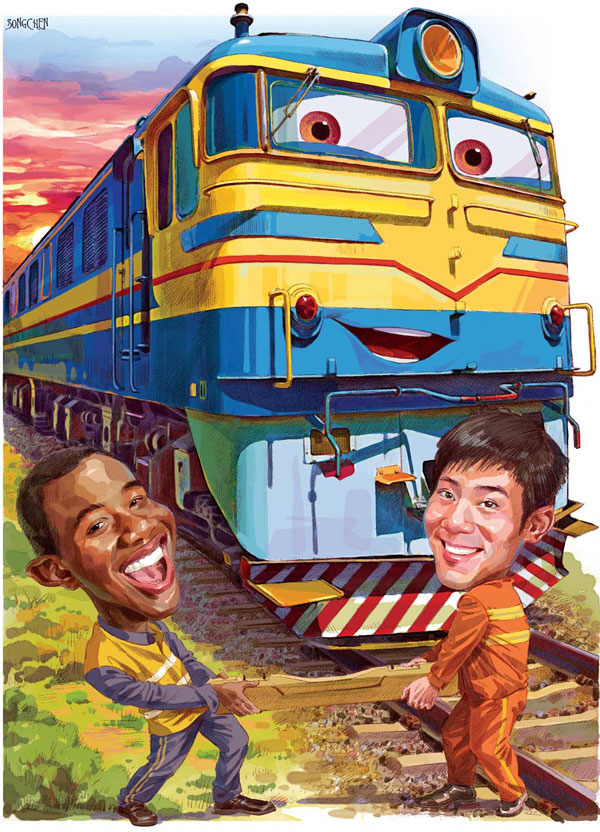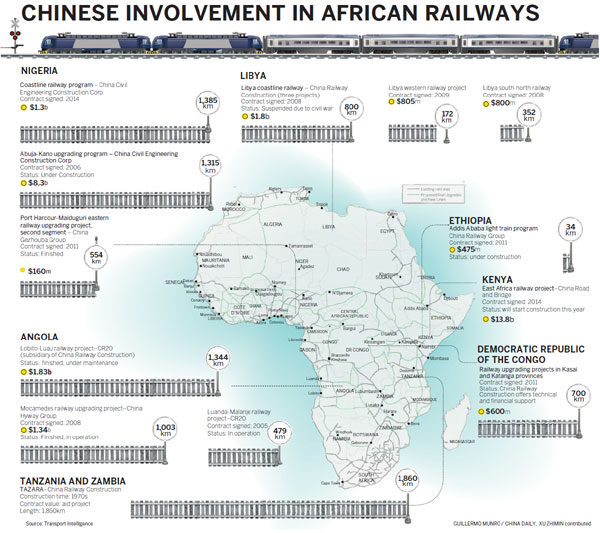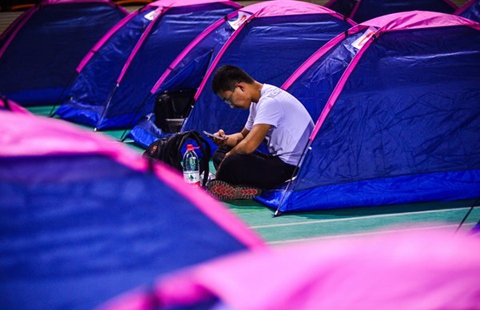

China again plays key role in redevelopment and expansion of africa's network of railroads
Africa is witnessing a new wave of railway construction, with China playing a pivotal role.
The continent's first rail revolution took place around a century ago, when European colonials, for the most part, engineered the construction of hundreds of kilometers of track through deserts and forests, to transport their valuable cargoes of coal and precious metals.
Those early narrow-gauge railways could handle steam trains traveling at up to just 40 km per hour, and their loads were limited.
Today, however, Africa's ever-growing industrial and passenger demands - as economies across the continent accelerate - are many times larger than those of the early 1900s.
Many of those original tracks have been destroyed by war, or are now in such a state of disrepair that they are next to useless. Only some have been salvageable.
But the emphasis now is very much on new development, and opportunities abound to create the next generation of African railways - a fact not lost on many Chinese companies, already highly experienced from dragging their own country's rail industry into the 21st century.
One of those is CR20, a subsidiary of China Railway Construction Corporation, which has just completed the upgrading of 1,344 km of tracks across Angola, stretching from the country's eastern border city of Luau to the west-coast port of Lobito.
The massive undertaking is now being hailed as the most significant Chinese-built railway in the continent, since the governments of Tanzania, Zambia and China joined forces to build the now-iconic TAZARA Railway in the 1970s. That railway eliminated landlocked Zambia's then economic dependence on Rhodesia (now Zimbabwe) and South Africa.
In May, during Premier Li Keqiang's visit to Kenya, further details emerged of another milestone Sino-African rail project, the Mombasa-Nairobi standard-gauge railway project by China Road and Bridge Corporation.
Li noted that 570 Chinese managers and engineers had already arrived in Kenya, and 2,160 local workers had been recruited.
The railway will connect the port city of Mombasa and the capital Nairobi and stretch 485 km, carrying passengers at speeds of 120 kmh and freight at 80 kmh.
He witnessed the signing of the loan agreement for the standard-gauge railway project alongside the heads of state of neighboring East African countries involved.
According to the long-term plan, the railway will be extended to another five countries - Tanzania, Uganda, Rwanda, Burundi and South Sudan.
The entire project is estimated to cost $13.8 billion and when finished, the transport time between the two Kenyan cities will be cut from 15 hours to just four.
Railway construction remains capital-intensive, and most African countries simply cannot afford the huge outlays required.
But China has been able to step in and offer the considerable lending clout of two of its largest banks - the Export-Import Bank of China and China Development Bank.
With financial guarantees from the African governments involved, the Mombasa-Nairobi railway has secured $3.8 billion in loans from the China Exim Bank, meaning work can start this month.
Official figures show that China Development Bank has now issued more loans to Africa than the World Bank, the African Development Bank and the Asian Development Bank combined.
Wei Ruihai, vice-president of the private construction company China Hyway Group, one of the country's leading manufacturers specializing in high or low voltage electrical systems, says financing channels are limited in Africa, meaning many local companies are unable to bid for mega-projects in the way that Chinese companies can.
"The deposit rates charged by local banks are often higher than 20 percent and loan interest even higher than that, so it is unwise to borrow large amounts from them," he told China Daily.
To renovate the 1003-km Mocamedes Railway in Angola - linking the coastal desert city of Namibe in the southwest of the country to Menongue, the capital of Cuando Cubango province to the east - Hyway was able to bid $1.3 million per kilometer - a third of the price of its rival Portuguese bidder.
During his multi-country African trip in May, Premier Li promoted China's considerable expertise in the development of high-speed trains, as he has frequently advocated on other trips overseas.
A month later, for instance, while he was in London to meet UK Prime Minister David Cameron, it was announced that China had been offered a decisive stake in the next stage of Britain's transport infrastructure by helping to build its future high-speed rail lines.
But experts have suggested that massive high-speed railway construction is not possible in Africa in the near future.
Wei from Hyway says that light urban train systems are necessary in African countries because congestion remains a serious issue, "but apart from that, any high-speed train would be too ambitious for most sub-Saharan countries".
"In Africa, the population is concentrated in big cities, and other places are sparsely populated. So a high-speed train would not carry enough passengers to justify the cost, given that 1 kilometer of high-speed track can cost more than $50 million.
"Relatively developed countries such as South Africa and Nigeria might be able to build them, but it is still far off for other countries," Wei adds.
Kenya's cabinet secretary for transport and infrastructure, Michael Kamau, says his country's railway-building program is certainly crucial to raising its competitiveness, explaining that high logistics costs have hammered Kenya's products on the international market.
"Average transport cost makes up about 40 to 45 percent of total costs, while the average level internationally is 15 percent," he says.
He adds that 90 percent of goods in China and India are transported by train, but in Kenya that figure is just 5 percent.
To save time and money, many African countries have favored upgrading tracks and stations over new railway construction.
But that type of project is often no easier, says Liu Feng, director of CR20's Angolan project, who rather bluntly describes the conditions of the country's railway network as "tragic".
"After 26 years of civil war, the roofs of stations were gone, the crossties were missing and trees had been allowed to grow on the tracks."
Then there was the added danger of landmines buried along the lines, which had to be removed with the help of the Angolan army, before construction even started.
A lack of basic construction materials locally and lack of qualified workers, also had to be dealt with.
Everything needed to be shipped from China, including huge quantities of cement and often bulky, heavy machinery.
It's only very recently that Chinese companies have begun to establish their own plants to process basic rail-building materials locally, such as crushed stones and crossties.
The railway-building industry is still highly technical, requiring workers to adhere to strict quality controls. Hyway, for instance, had to fly in thousands of qualified workers from China to Angola, each commanding an annual salary of 100,000 yuan ($16,200) - far above what local workers might have expected.
Of course, many countries in Africa have railway networks in place, but the majority are woefully under-maintained or even derelict.
The iconic TAZARA railway, the Tanzania Zambia Railway Authority, is typical.
For decades, it was trumpeted as a defining symbol of friendship between China, Tanzania and Zambia, but today long stretches of it sit practically deserted.
Linking more than 100 stations from the port of Dar es Salaam in Tanzania with the town of Kapiri Mposhi in Zambia's Central Province, the single-track, 1,860 km line took five years to build, and was completed two years ahead of schedule at a cost of $500 million, to become the single longest railway in sub-Saharan Africa, and China's largest single foreign-aid project.
According to official records, China sent around 50,000 personnel to Africa to help build the railway from 1965 to 1976, including 30,000 to 40,000 workers. An estimated 60,000 Africans worked on its construction, and at the height of activities in 1972, there were 13,500 Chinese and 38,000 African workers on the project.
Chinese assistance then was provided largely by the Railway Engineering Corps, then part of the People's Liberation Army and the foreign aid department of the Ministry of Railways, which has since become the China Civil Engineering Construction Corporation.
TAZARA's business still involves freight and passenger services, and it is considered a major transporter of copper and other minerals out of Zambia - but the railway has just 10 trains in full service, all more than a quarter of a century old.
The whole railway ground to a halt at one point last year because of chronic lack of maintenance.
Its total annual cargo tonnage has dropped from 1.27 million tons in its heyday, to 400,000, while just 790,000 passengers traveled on the system in the last financial year.
Only 6,300 km of the railway is considered active, with many extensions abandoned, and frequent problems with decrepit lines and old locomotives. Many businesses have moved to more efficient road transport, as trucks out-compete rail transport.
The main challenge for the region's rail lines remains speed restrictions and unavailability of rolling stock.
However, plans are well underway to return the iconic line to something near its former glory, through renovation and introducing a modern management system, as well as new rolling stock, mainly from China.
The latest statistics show that TAZARA has the capacity to transport 5 million tons of cargo and 3 million passengers annually.
Last year, the company unveiled a $122 million, five-year plan to buy 10 trains from China to bring up the annual cargo transportation to 1.5 million tons by 2018.
The project will include upgrading the existing track, improving telecommunications and signaling systems, and developing trading services and parking lots on earmarked network sections.
Around 15 percent of that budget will come from the private sector.
In December, TAZARA sealed a contract with the Chinese Civil Engineering and Construction Company for the manufacture and supply of four new locomotives and spare parts.
Ronald Phiri, TAZARA's acting managing director, and Miao Zhong, CCECC's railway experts team leader, say the locomotives are expected to be delivered by December, adding to six that arrived last year.
Phiri adds the strategic plan would help the company escalate the volume of cargo and revenue this year.
"The sooner we get these locomotives and start delivering on our 2014/2015 targets, the better," he noted at the signing ceremony, emphasizing that the idea was to improve both availability and reliability of equipment.
TAZARA now has a fleet of about 16 mainline locomotives at its disposal, and the Tanzanian and Zambian governments are already considering amending their TAZARA laws, passed in 1975, which banned foreign investment in the railway, meaning that future funding will no longer be restricted to aid or charity.
Chinese companies have already made large investments in financing African rail projects, tempted not only by the profits involved in building the lines themselves, but also by the potentially improved access to natural resources.
Last year, for example, Zambia's Luanshya Copper Mine, one of the oldest mines in southern Africa, 85 percent of which is owned by China Nonferrous Metals Company Ltd, enjoyed a resurgence in fortunes.
The mine was shut down in 2008 at the height of the global financial crisis, but the company reopened it in 2009 after extensive modernization.
In April 2012, the $368 million Muliashi copper project was completed, which extended the life of the mine and expanded annual production to over 41,000 tons of copper, up from its previous 21,000 tons. A rejuvenated local TAZARA lines means they can transport ore far more quickly to port.
China Railway Construction Corporation, and its predecessor, the Railway Engineering Corps, used to be the only Chinese company eligible to build railways in Africa.
But today it has multiple competitors, including China Railway Group, China Road and Bridge, Sinohydro Corporation, and various private companies, which have broken the monopoly of the state-owned giants on overseas rail construction.
China Hyway was among the first private Chinese companies to successfully bid for an African rail contract.
Its Mocamedes rehabilitation project was completed in 2012, and started trial runs soon afterward.
The company is now talking with the governments of Mozambique, Namibia and Botswana to build a further 1,000 km of line linking the countries.
The quality of Chinese railway construction, experts say, remains a big selling point.
During every bidding process, Chinese companies are questioned extensively about safety and reliability, but according to local officials, their reputation has grown stronger.
The director of Angola's National Railway Institute, Julio Bango Joaquim says Chinese companies' quality has been good.
"Industrial standards have evolved with globalization, so no matter whether European or Chinese standards, quality is the only thing that matters.
"The quality of Chinese standards is trustworthy as we have seen the railways operating safely."
Zhong Nan contributed to the story.
wangchao@chinadaily.com.cn
|
During his African trip in May, Chinese Premier Li Keqiang witnessed the signing of the loan agreement for the Mombasa-Nairobi standard-gauge railway project. Li Xueren / Xinhua |

(China Daily Africa Weekly 09/05/2014 page1)








